
Text © Prof. Paolo Grossoni

English translation by Mario Beltramini
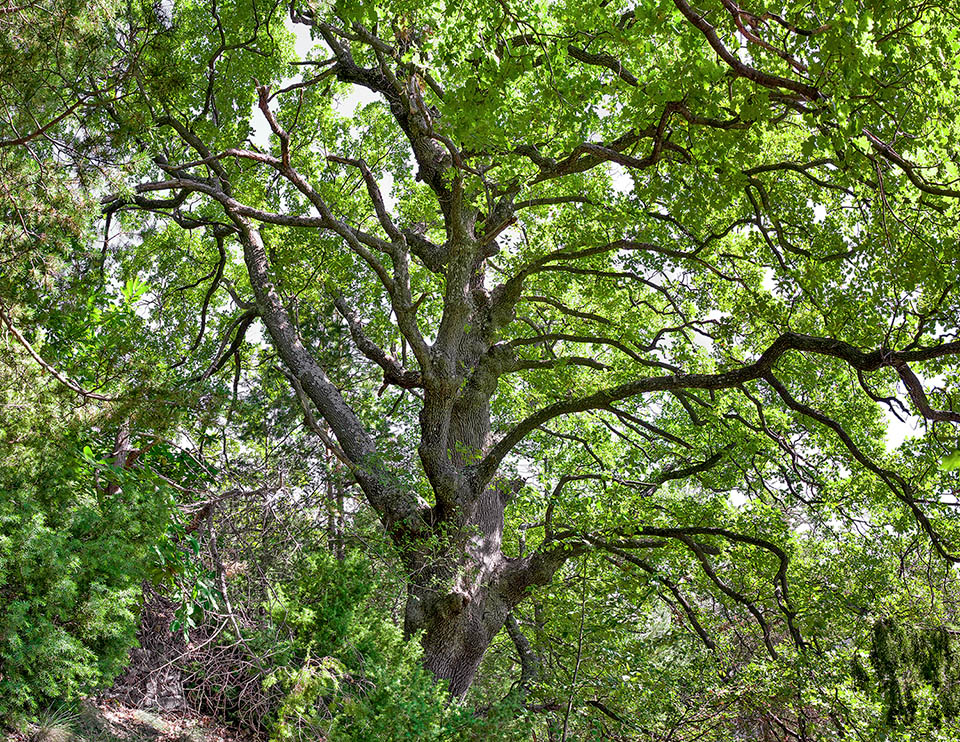
Adult specimen of Downy oak (Quercus pubescens) in its natural environment. Are numerous the tree oaks that acquire a majestic habitus over time © Giuseppe Mazza
Fagaceae is a family of the order Fagales Engl. which since the last revision carried out in 2016 by the Angiosperm Phylogeny Group (APG IV) is composed of seven families: Nothofagaceae Kuprian (1 genus; South America and Oceania), Fagaceae Dumort. (8 genera; northern hemisphere), Myricaceae Rich. ex Kunth (3 genera, cosmopolitan); Juglandaceae DC. ex Perleb., (9 genera; Eurasia and American continent), Casuarinaceae R.Br. (4 genera; Oceania and Southeast Asia), Ticodendraceae Gómez-Laur. & L.D.Gómez, (1 monospecific genus; Mexico and Central America) and Betulaceae Gray (6 genera; northern hemisphere), for a total of 32 genera and about 1,300 species, all woody.
The order, established by Adolf Engler in 1892, included Fagaceae and Betulaceae; later on, also Balanopaceae and Ticodendraceae have been inscribed in the order. In 1998 the first revision edited by the Angiosperm Phylogeny Group modified the order by detaching the Balanopaceae and inserting Myricaceae, Juglandaceae, Casuarinaceae and Nothofagaceae (the latter is a newly created family; previously, Nothofagus was a genus included in the Fagaceae).
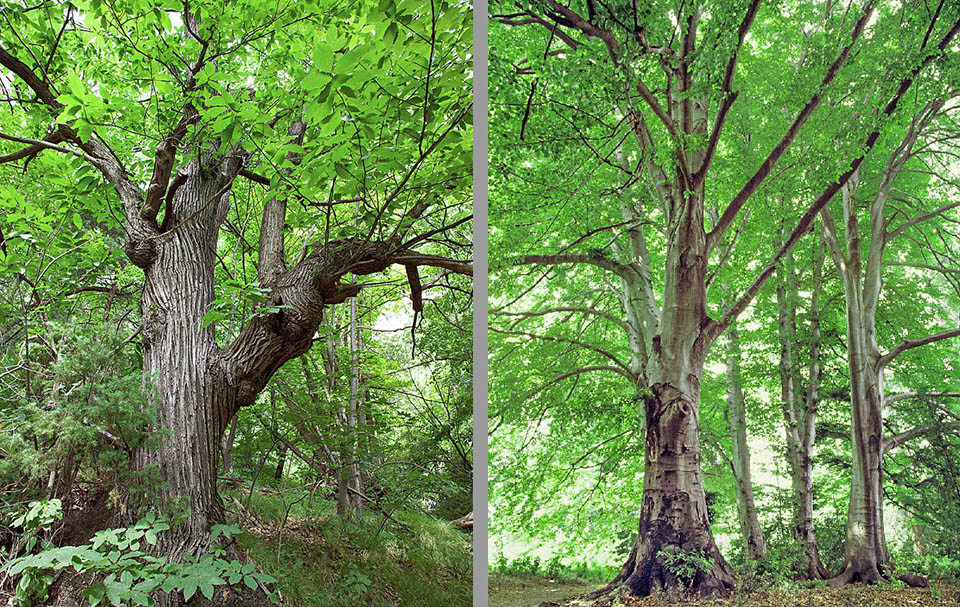
The Sweet chestnut (Castanea sativa) and the Common beech (Fagus sylvatica) are other two Fagaceae that, like the corresponding American species, can reach remarkable sizes. The beeches are easily identifiable by the bark which is always smooth and light gray whilst in the adult chestnuts it is deeply furrowed © Giuseppe Mazza
In this way, recent revisions have modified the structure of both the order and its families within which important changes have been made. The pistillate flowers, provided with an inferior ovary subdivided in 3-(6 or more) carpels, are contained within protective membranous involucres which subsequently, differ in the cupules that, partially or totally, envelop the fruits.
The Fagaceae are made up of mainly tree species with only macroblasts (long shoots with clearly visible internodes) or even brachyblasts (shorts shoots); they have sessile and pauci- or pluriperulate buds with imbricated scales; in chestnut trees the terminal bud sheds and it is the bud immediately below one that sprouts producing the new branch (sympodial branching). The leaves are dorsiventral, pinnately veined, and alternate spirally arranged but, often, apparently distichous (two ranked leaf arrangement), due to the twisting of the petiole in order to expose the largest possible surface to the light. They are simple, with deciduous stipules; the blade, more or less leathery and thick, from glabrous to thickly pubescent, is oval to elliptic-elongated with a long pointed apex; the margin is mostly serrate, but in many species, is entire, toothed or lobed. The leaves fall in autumn (deciduous) or from the end of the second year (persistent) or, more rarely, semi-persistent because they in the following year during the sprouting of the new ones.
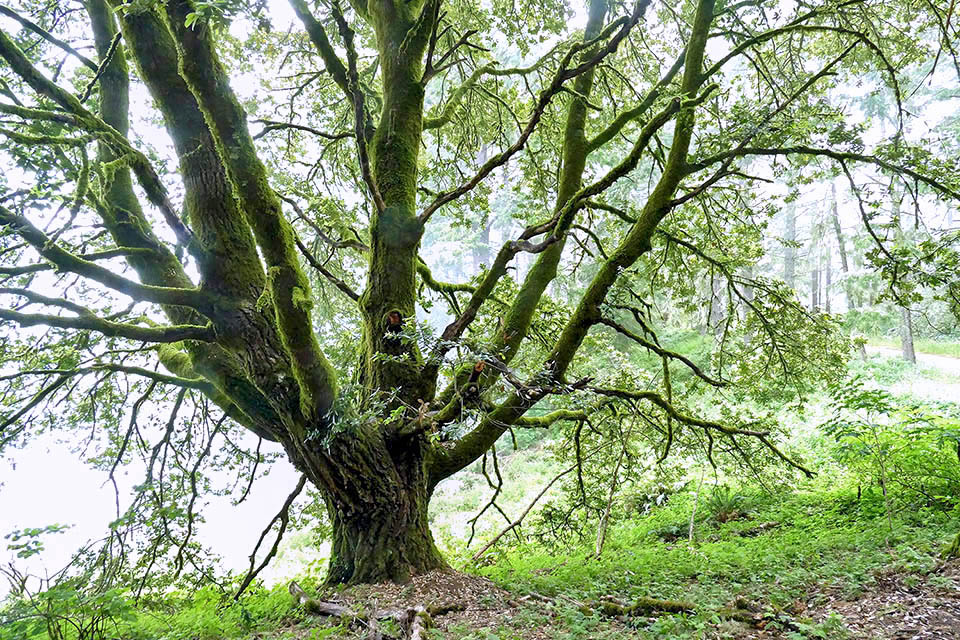
Notholithocarpus densiflorus is widespread along the coasts of western US, from southern Oregon up to almost all California. It can exceed 30 m but, usually, it is a small tree of about 10-15 m. The basal part of the trunk is greatly enlarged and the branches start almost immediately. It is an evergreen not standing frost © Alice Cummings
The wood is discoloured with the outermost part, (sapwood) from ivory white to yellowish or pale grey and the internal one (heartwood) more or less intensely coloured from grey to brown or from orange to reddish; tipically it is heavy, hard, solid and resistant to parasites. Depending on the distribution of the woody vessels (or ‘pores’) in the annual ring and of the diameter of their cellular lumen, the wood of the species is divided into ‘ring-porous‘ (the spring wood vessels have wider diameters) or ‘diffuse-porous’ (vessels are evenly distributed in annual ring) or, again, ‘semi-porous‘ (intermediate porosity between the first two). Not in all species the annual rings are easy to distinguish.
The species are mainly monoecious, whilst the dioecious ones are rare; they have unisexual or mixed (androgynous) inflorescences; the staminate and the androgynous ones are catkins (heads in Fagus) rigid, lax or flexible, erect or pendulous. The pistillate inflorescence are mostly spikelets bearing 1-3 (15) flowers enveloped in involucral bracts which, in most cases, fuse and harden transforming into the characteristic cupules of this family. Lithocarpus and Notholithocarpus can have solitary flowers. Inside the involucre; the basic number of flowers is 3, but, in the course of the evolution, this configuration has modified: in Quercus, Lithocarpus and Notholithocarpus, only the central flower is fertile whilst in Fagus it is the central flower which is sterile; in Castanopsis. and Chrysolepis the number of the functional flowers varies from 1 to 3 and in Trigonobalanus (the Trigonobalanoids are the most archaic taxa of the family) there can be from 1 to 7 flowers in the same involucre.
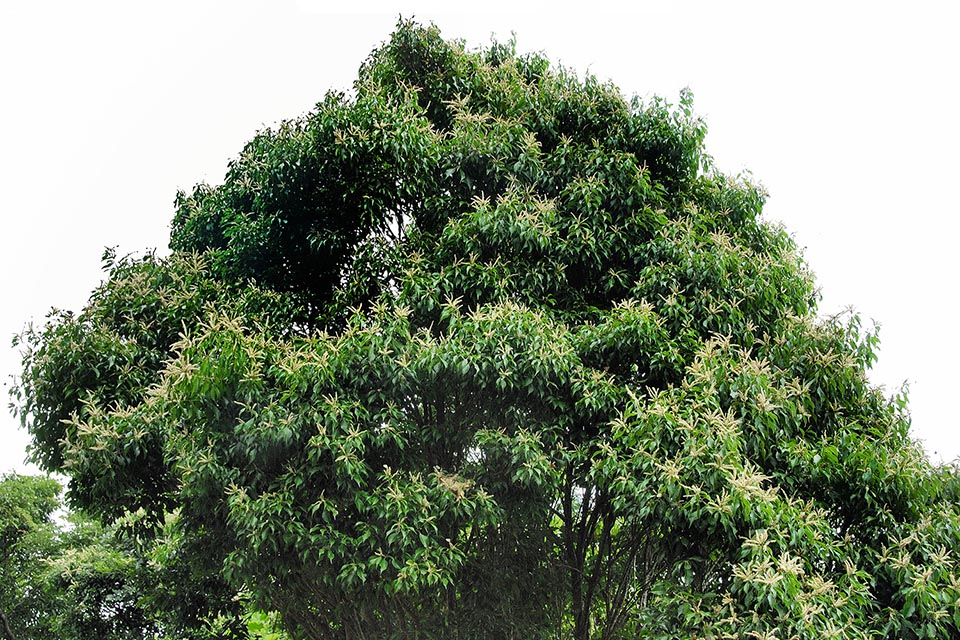
Lithocarpus konishii is a small Asian evergreen tree reaching 4-5 m of height. After the oaks, the genus Lithocarpus is the most numerous © Ming-I Weng
At the beginning of the differentiation the flowers are bisexual, then either the stamens or the pistils transform and become sterile and the flowers remain unisexual; they are apetalous with a little calyx. The staminate flowers have (6) 8-20 (60) stamens whilst the pistillate ones have the ovary with 3(6) unistylar carpels (in Castanea they are 6-9) and containing two ovules each. The first fertilizated ovule inhibits the other 5 ovules that abort and therefore every fruit contains only one seed. With the exception of Fagus and Quercus, the involucres are inserted, single or aggregated in a limited number (2-5), along the basal portion of staminate inflorescences that in this way become androgynous. Pollination is anemogamous but in Castanea, Castanopsis and Chrysolepis, it can also be carried out by insects attracted by the presence of nectaries and by the emission of aromatic substances.
The cupule (or ‘cup’), with a more or less long peduncle, is mainly derived from the involucre which during the development of the fruit has more or less lignified the (1) 2-4 (8) valves by welding them or fusing them together whilst the outermost bracteoles have transformed into small scales, concrescent rings of scales, spiny process or stiff spines also very sharp., in thorns or in concrescent rings of scales. Depending on the species, the cup partially or totally includes the fruits in a number corresponding to that of the fertile flowers of the inflorescence involucre. In Notholithocarpus and in Trigonobalanus and in part of Quercus and Lithocarpus, the fruit is only partially included in the cupule which has the shape of a cup, bowl or saucer; in the other species of Quercus and Lithocarpus and in all other genera the cup totally encloses the fruit even if in Castanopsis the cup may begin to open when still on the plant.
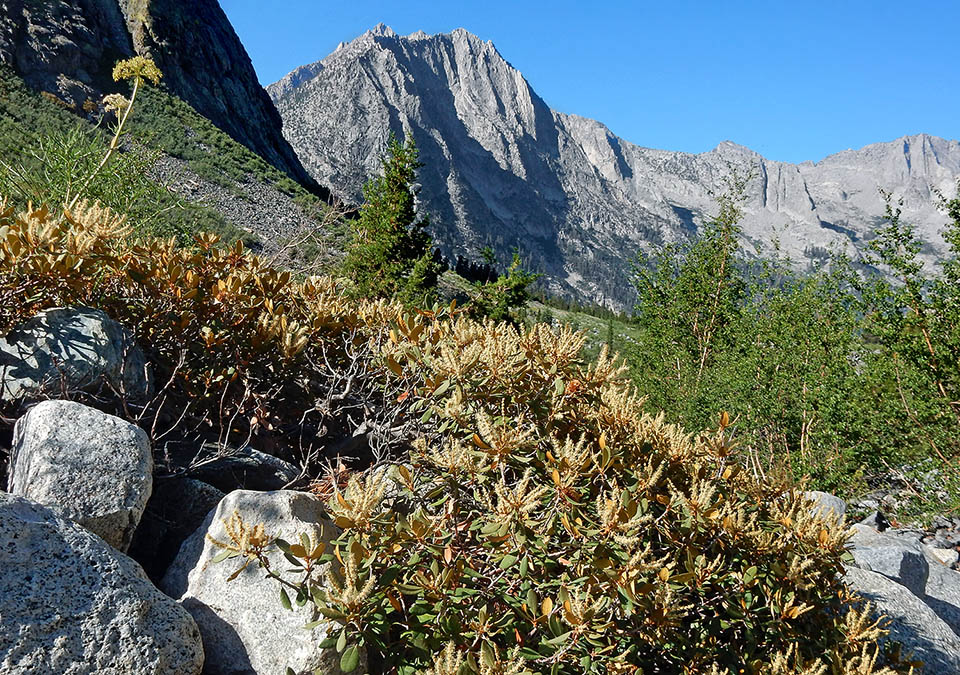
But among Fagaceae there are also shrubs, such as Chrysolepis sempervirens, a 2-2,5 m evergreen that grows in Oregon and California up to more than 3,000 m of altitude © Matt Lavin
The fruit is a trigonal nut (Chrysolepis, Fagus and Trigonobalanus), ovoid or turbinated (like an inverted cone) which ripens in the year (Fagus, Castanea, and part of the oaks) or in the following one (the other oak species and the other genera); the seed is devoid of endosperm and the nutrients for the embryo are stored in the cotyledons. In all Fagaceae the internal integument of the fruits (endocarp), in contact with the seed, is densely pubescent; also the number of the valves has diagnostic value because in Lithocarpus, Notholithocarpus and Quercus the cup is made up by only one piece (even if, in reality, in oaks it derives from the total fusion of 2 valves), whireas Castanea, Castanopsis and Fagus have the cup formed by 4 valves and Trigonobalanus by 5 and in Chrysolepis the cup has a variable number (often 7, of which 2 internal) free and not fused.
During germination, the cotyledons remain inside the teguments (hypogeal germination); the beech seeds are deeply dormant whilst those of the other genera are not dormant and germinate readily even if, i.e., in Quercus and Castanea, it is then the seedling that enters a dormancy phase. The conservation of the seeds, even dehydrated and conserved at temperatures close to 0 °C, is not easy because they are ‘recalcitrant‘ and quickly lose their germination capacity (Castanea, Lithocarpus, Notholithocarpus, Quercus and Trigonobalanus) or they are ‘suborthodox‘ and can be conserved for a maximum of 4-6 years.
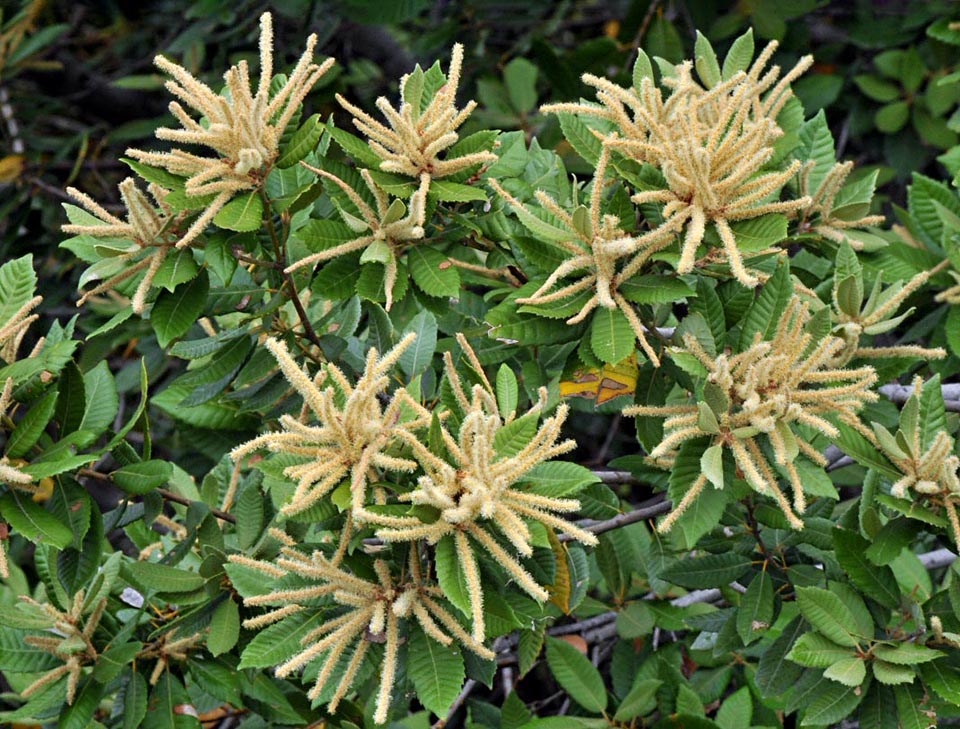
In inflorescence there is a certain family air. Notholithocarpus densiflorus has erect catkins with only staminate flowers or mixed with pistillate at the base © Marc Kummel
The chromosome number is 2n = 24, the only exception is Trigonobalanus (2n = 14); there are no known cases of polyploidy among natural populations. One of the reasons for the shift of the genus Nothofagus to another family is due to the fact that all species are 2n = 26.
Almost one thousand species are ascribed to the Fagaceae: 927 according to Christenhusz and Byng and 969 according to The Plant List, distributed among 8 genera in turn aggregated into the subfamilies of Fagoideae and Castanoideae.
. Fagoideae with Fagus L.; about ten deciduous species widespread in the temperate regions of the northern hemisphere;
. Quercoideae with the other genera:
– Castanea Mill.; 8 deciduous species widespread in the northern hemisphere;
– Castanopsis (D.Don) Spach; 120 evergreen species from tropical and subtropical regions of central-eastern Asia, continental and insular.
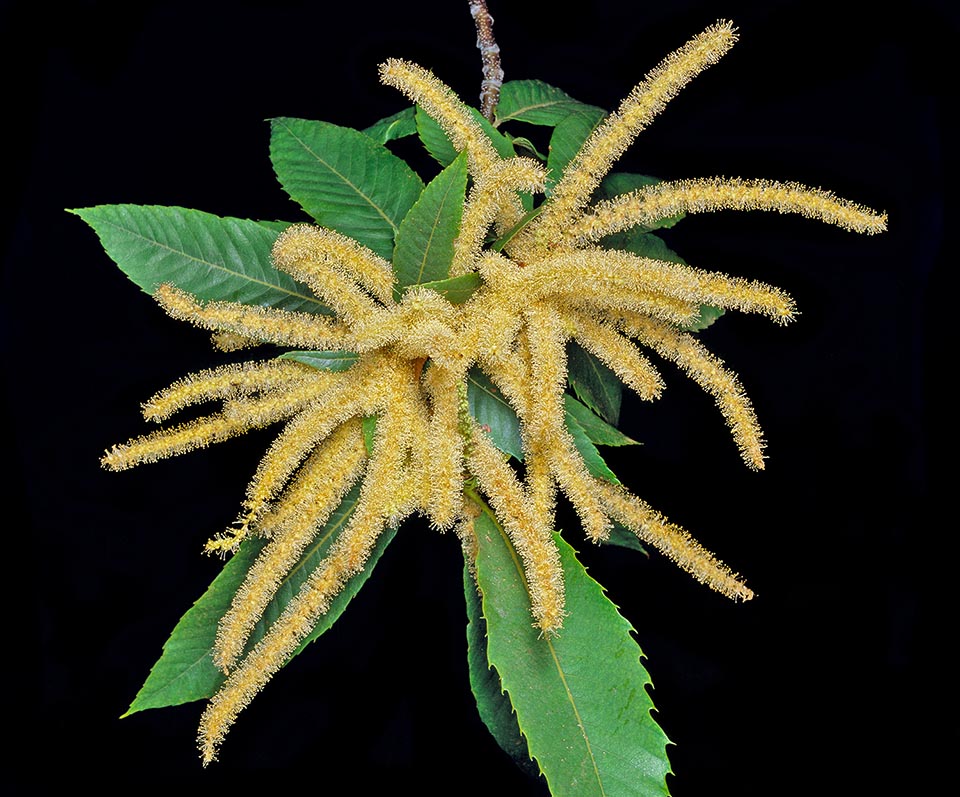
Also the Sweet chestnut (Castanea sativa) inflorescences are erect catkins unisexual or mixed. This is one of the tree species with latest blooming © Giuseppe Mazza
– Chrysolepis Hjelmq.; 2 evergreen species of the west US coast, from California to Washington state;
– Lithocarpus Blume; about 300 evergreen species, with a natural range similar to that of Castanopsis but missing in the Indian region;
– Notholithocarpus Manos, Cannon & S.H.Oh; 1 evergreen species in California and in Oregon;
– Quercus L., 530 deciduous, semi-persistent and evergreen species, widespread throughout the northern hemisphere;
– Trigonobalanus Forman; 3 evergreen species with disjointed ranges. In 1989 Nixon and Crepet proposed splitting the genus in 3 new monospecific genera: Trigonobalanus Forman and Formanodendron Nixon & Crepet (Southeast Asia) and Colombobalanus Nixon & Crepet (Colombia).
In addition to the drastic transfer of the genus Nothofagus in another family and the proposal to the genus Trigonobalanus, in the Fagaceae there are several species considered as ‘critical’ and subject to taxonomic revisions.
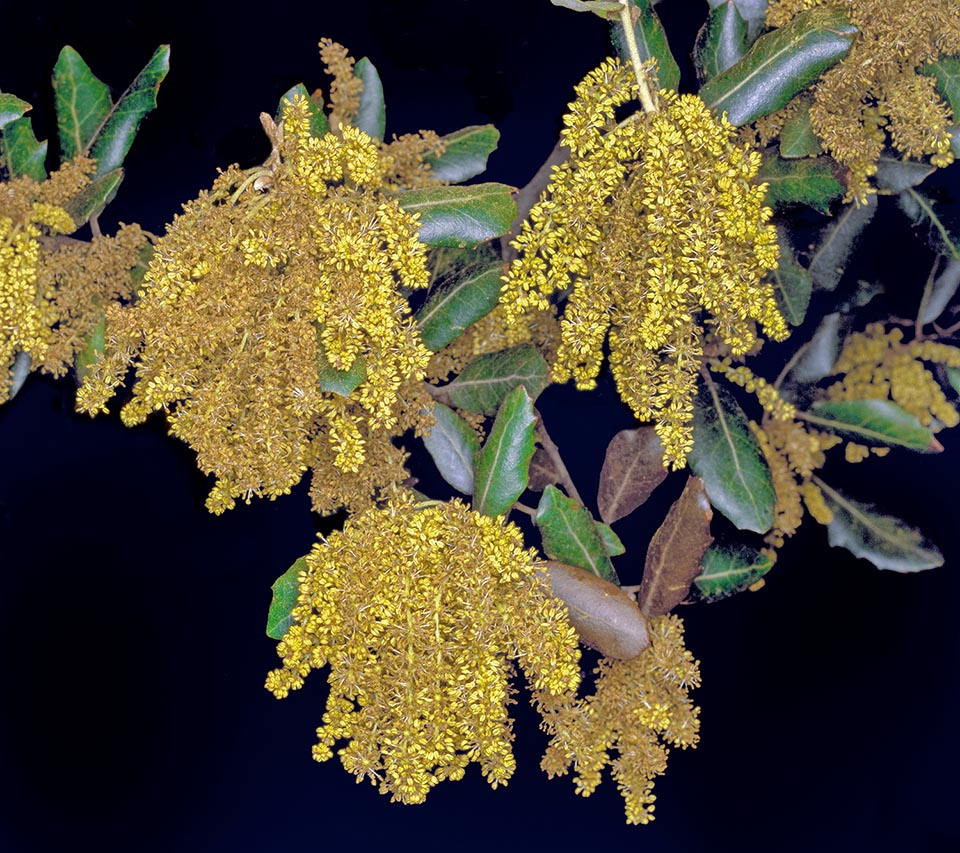
The Holly oak (Quercus ilex) however has a variant. It has male flowers, here shown, merged in pendulous catkins, whilst the pistillate inflorescences are short and erect © Giuseppe Mazza
Some examples, Notholithocarpus densiflorus (Hook. & Arn.) Manos, Cannon & S.H.Oh, endemic to California and southern Oregon and the only species of its genus, until a few years ago it was included in the genus Lithocarpus and before that it belonged to the genus Pasania (Miq.) Oerst., genus later suppressed and unified with Lithocarpus. The Oriental beech (Fagus orientalis Lipski), initially described as a species, was included in F. sylvatica L. (the European beech) in 1986 but has recently been brought back to the rank of species. Also Quercus calliprinos Webb, classified in 1838 as species, has been later on considered a subspecies of Q. coccifera L. (stenomediterranean species), then brought back to the rank of species and now reconsidered as subspecies of Q. coccifera. Also due to the large number of taxa, inside the family, most of the taxonomic research works focuses on oaks.
The Fagaceae are very common and above all widely spread in hilly and mountainous areas of most of the temperate, subtropical and, albeit less involved, also tropical regions of the northern hemisphere where they form pure forests but usually mixed with conifers (specially Abies, Picea and Pinus) and other broad-leaved trees. The great variability of habitats which they live reflects different ecological needs not only between the genera but also between the species in a same genus making it difficult to summarize briefly the fundamental aspects of different ecological behaviours.
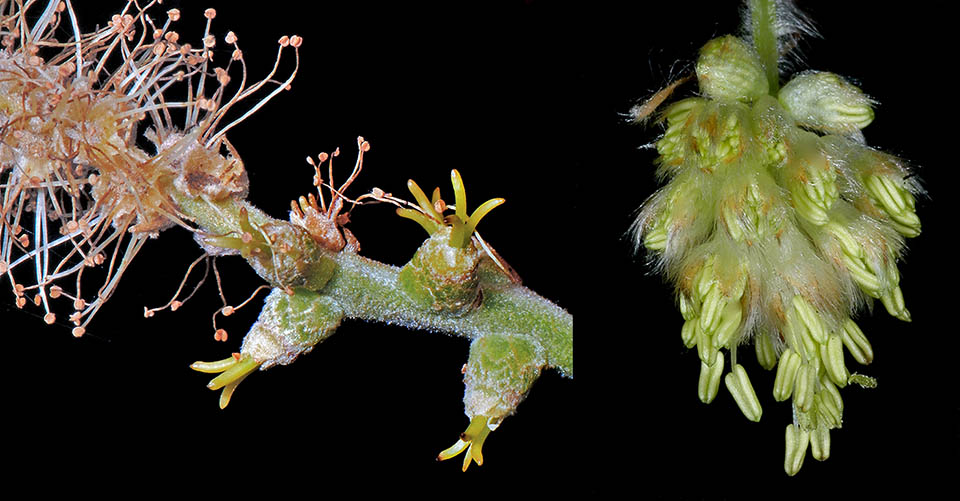
Here compared the inflorescences (catkins) mixed of staminate and pistillate flowers of Lithocarpus konishii and the only staminate, unisexual, of Fagus sylvatica that instead is a head inflorescence where the stamens and relevant anthers are clearly seen. In the photo, along the Lithocarpus konishii hairy rachis, the staminate flowers have 10-12 long stamens whilst the pistillate ones have a coniform ovary from which 3 (4) styles are emerged © Ming-I Weng (left) and © Robert Combes (right)
For the same reasons, it is too complex to synthesize the pathologies that affect these plants or the parasites that infesting them. In any case, it should be borne in mind that, in addition to the pathogens that damage branches and leaves or cause cancers or rot to branches, trunks and roots, even extensive damage is caused by several lignivorous or defoliating insects and that birds and mammals, especially rodents and ungulates, love their fruits eliminating most of them. In addition to these extensive and serious damages, human interventions have destroyed entire forests of these species which have often been replaced by urban and industrial settlements or the planting of specialized crops such as chestnut groves, poplar groves, orchards, vineyards, agricultural crops, pastures and so on
Depending on the timber assortment, the Fagaceae are managed as high forest as well as coppice. Since the dawn of civilization, their wood has accompanied the man in his activities both to produce heat (firewood and derived coal) and to obtain material for multiple use: building and naval constructions, beams, boards and poles, furniture, plywood, veneers, cellulose pulp and numerous other small manufactured necessary for multiple uses (barrels and railway sleepers, rifle butts, tools for work or for recreational activities, etc.). It is also from wood, but also from barks and cupules that tannins are obtained for the tanning of leathers or for the production of inks, lacquers and as mordants in the dyeing of fabrics; moreover, they also enter into preparations for herbal medicines and cosmetics.
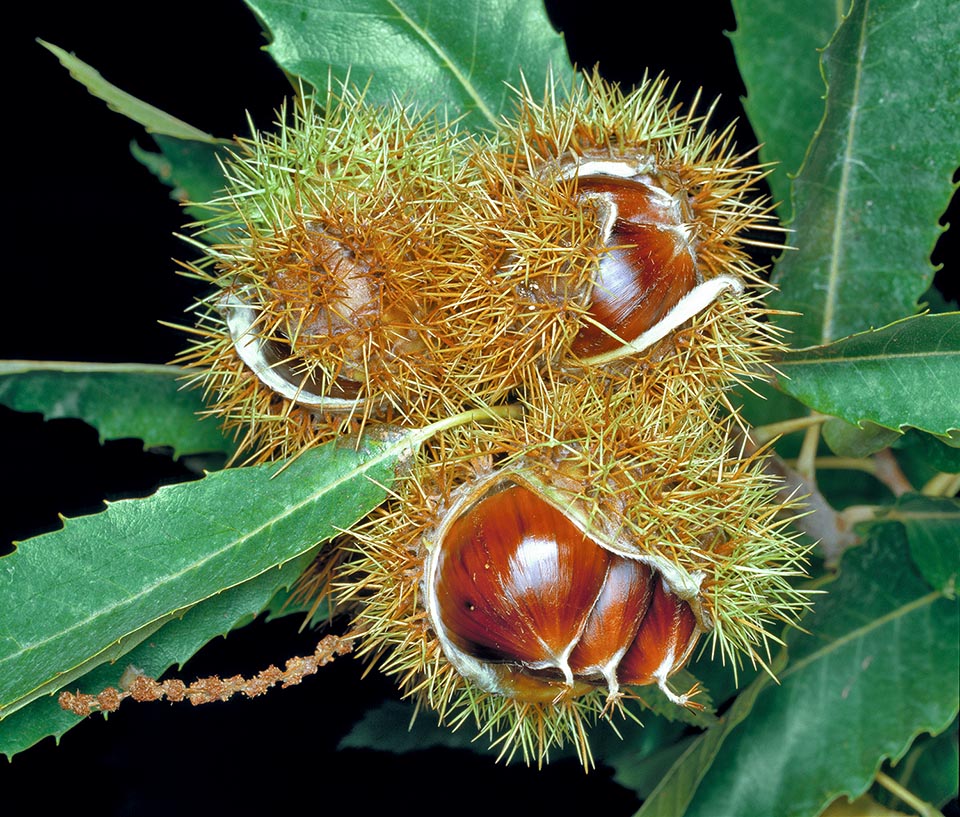
After pollination and fertilization have taken place the staminate flowers die, whilst in the pistillate ones the ovary turns in fruit, protected by a cupule. In Fagaceae the number of fruits varies. I.e. in the Sweet chestnut, the cupule, commonly called burr, fully contains 3 fruits, the chestnuts, that ripen throughout the year © Giuseppe Mazza
Their extracts are employed in phytotherapy as antiviral drugs and, above all, as analgesics, antiseptics and vasoconstrictors. The fruits of some chestnuts enter the human diet and those of several other Fagaceae are used by wildlife and for the livestock farming.
Finally, several species are employed in the landscape design thanks to their form, for longevity, posture and substantial canopy of foliage, all values even more easily appreciated in isolated specimens.
In Europe are spontaneous Fagus (2 species), Castanea (1 species) and Quercus (about thirty species of which 8 are uncertain as “taxonomic rank”). The systematics of oaks has been always very complex and already in 1911 Antonino Borzi, director of the Palermo Botanical Garden, had written «[…] the genus Quercus represents the perfect negation of the concept of species […] it is an immense chaos […]». These difficulties are mainly due to the fact that often on the same territory there are several oak species that can be genetically compatible for this reason; cases of interspecific hybridization are possible that can lead to the affirmation of individuals with morphological traits more or less intermediate.
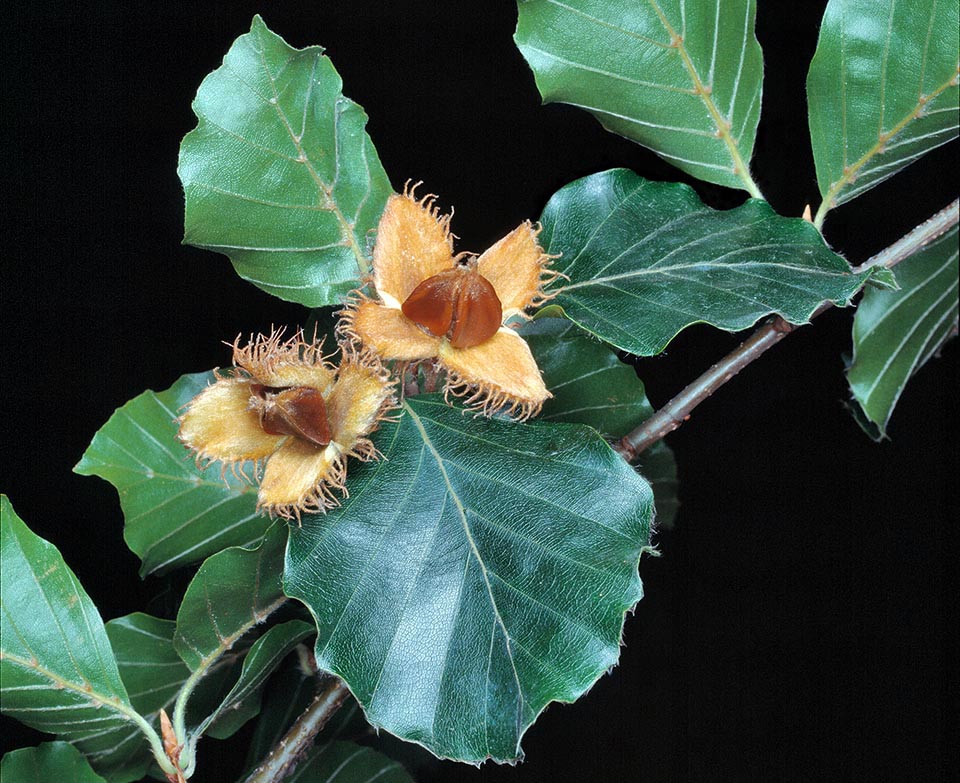
Also beeches have fruits completely contained into a cupule (only in Fagus japonica they partially get out) appearing covered by long rigid bristles, not too pungent. But unlike chestnuts, this contains only two fruits. In the European beech (Fagus sylvatica), they ripe throughout the year and are called beechnuts © Giuseppe Mazza
Although occasional, these hybridizations can nevertheless repeat themselves during the potentially long life of an oak; furthermore, it should be kept in mind that even hybrid plants can in turn be pollinated by oaks of one of the two parental species determining the introgression of further genes of that species and thus approaching more the resulting genome to that of one of the parental tree.
All this determines remarkable uncertainties and discrepancies that in turn interfer on the attribution of the taxonomic rank of a given taxon and consequently, also with its presence in a territory, even if it is limited. Examples of hybridization, spontaneous or made by the man are also known for Castanea, but the low number of species per geographic region (1 in Europe and Western Asia, 4 in Eastern Asia and 3 in North America) is such as not to create potential problems of classification. Regarding this genus, an intergeneric hybrid between Castanea and Castanopsis, ×Castanocastanea P.V.Heath, has been reported in North America.
The beeches (Fagus L.) are deciduous and not very long-lived trees that form large forests in the temperate regions.
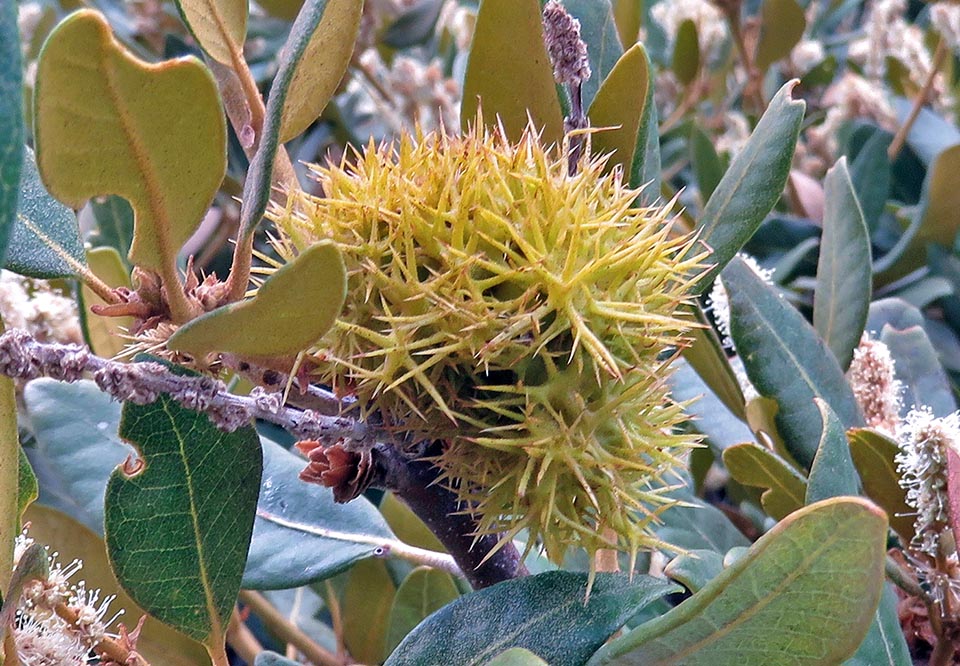
The densely prickly cupule of Chrysolepsis sempervirens encloses (1)-3 glabrous fruits which ripen in the second year. They are edible and attract squirrels © Wayne Washam
Morphological characters useful for the recognition are the rhytidome (the outermost bark) from light to bluish grey and always smooth, the long, spindle-shaped and pluriperulate buds of long shoots, the staminate inflorescences in flower heads of 6-16 flowers, and the pedunculated and oval cupules, with bristles and short and stout spines, that totally enclose two trigonal nuts. They tolerate low temperatures and shading and are more or less mesophilic with regard the water but, in any case, they avoid atmospheric dryness and periods of summer aridity.
Fagus sylvatica is the beech of western Europe, whilst F. orientalis occupies south-eastern Europe and western Asia from Anatolia to the Elburz Mountains; among the other beeches, of particular ornamental interest are American beech (F. grandifolia Ehrh.) and F. crenata Blume of Japan.
Chestnuts (Castanea Mill.), especially Castanea sativa Mill., can reach remarkable sizes and considerable ages. Famous are the “Hundred Horses Chestnut Tree” and the “Saint Agata Chestnut Tree”, in Sicily on the slopes of Mount Etna, which have a diameter of 7 m and an estimated age of about 2,000 years; the first one has formed a coppice which, thanks to the suckers that it has gradually produced, it has expanded over time to a diameter of about 22 m.
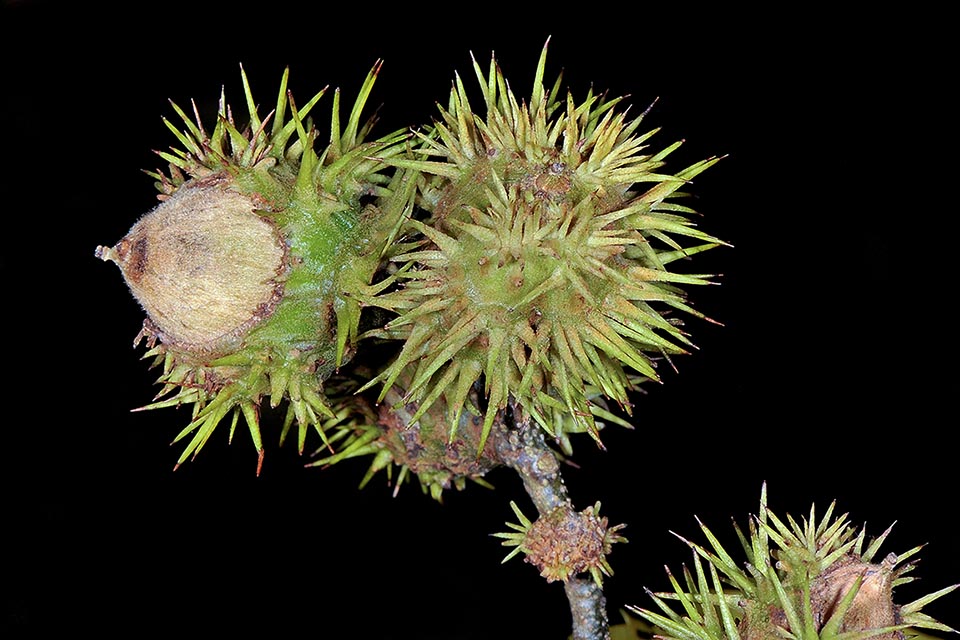
Also in Castanopsis jucunda the cupule is prickly. It contains only one fruit, partially visible. The genus Castanopsis, typically Asian, can bear 1 to 3 fruits © Ming-I Weng
The rhytidome, from smooth and grey to brownish in the young plant, thickens over time, cracking and forming raised cords very elongated longitudinally and slightly sinuous. The shoots have small, ovoidal and pauciperulate buds; terminal bud shed very early; the leaves, deciduous, are toothed and have a first herbaceous then leathery consistency.
The blooming is tardy (late spring – early summer) with erect inflorescences, male as well as androgynous; the cupule (“husk”), subspherical with a diameter of 5-10 (11) cm and covered by thorns even branched, rigid and very prickly, contain only one fruit (C. pumila (L.) Mill., C. ozarkensis Ashe, C. henryi (Skan) Rehder & E.H.Wilson and some chestnut cultivars; the first two species are American, the third one is Chinese), in the other species the fruits usually are 2 or 3.
Chestnuts are acidophilic and do not tolerate alkaline soils. Due to the late blooming, they still need relatively high temperatures at the beginning of autumn in order to ripen the fruits; for this reason in Europe, where chestnuts (C. sativa) were widely spread by the Romans, although it vegetates throughout central Europe, it regularly ripens the fruits only in the Mediterranean regions, provided not arid in summer.
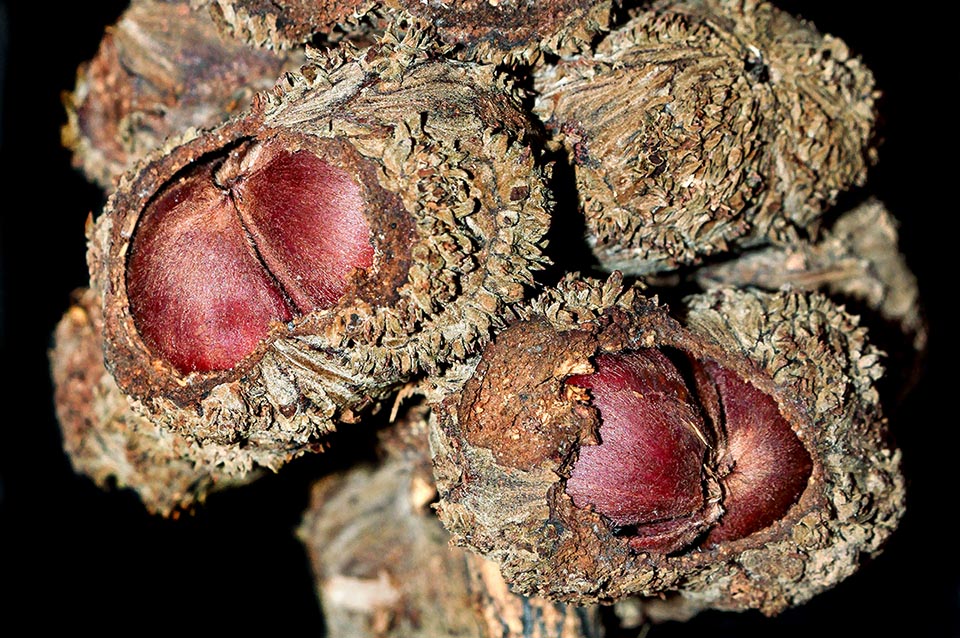
As the specific name states, Castanopsis inermis, present from Myanmar to Philippines, has quite massive cupules, not prickly, containing 2 edible fruits © Louise Neo
This inability was also described by Herman Hesse in the beginning of his “Narziß und Goldmund” set in Germany in the Baden-Württemberg.
The man has considerably diffused chestnuts for obtaining wood and derivatives and for fruits. Virtually, up the middle of the twentieth century, chestnuts were one of the essential sources for the sustenance of many European populations, however this intense cultivation of chestnuts in monospecific population has favored the spread of several diseases.
Among these, the most devastating for Mediterranean and American chestnuts has been the “Chestnut blight” caused by Cryphonectria parasitica (Ascomycota), now considered one of the 100 most dangerous harmful invasive species, which has caused very serious damages to the European chestnut heritage and has practically destroyed the American chestnut woods.
Despite this, in several European and Asian regions, chestnut trees are still intensively cultivated for the production of the fruits.
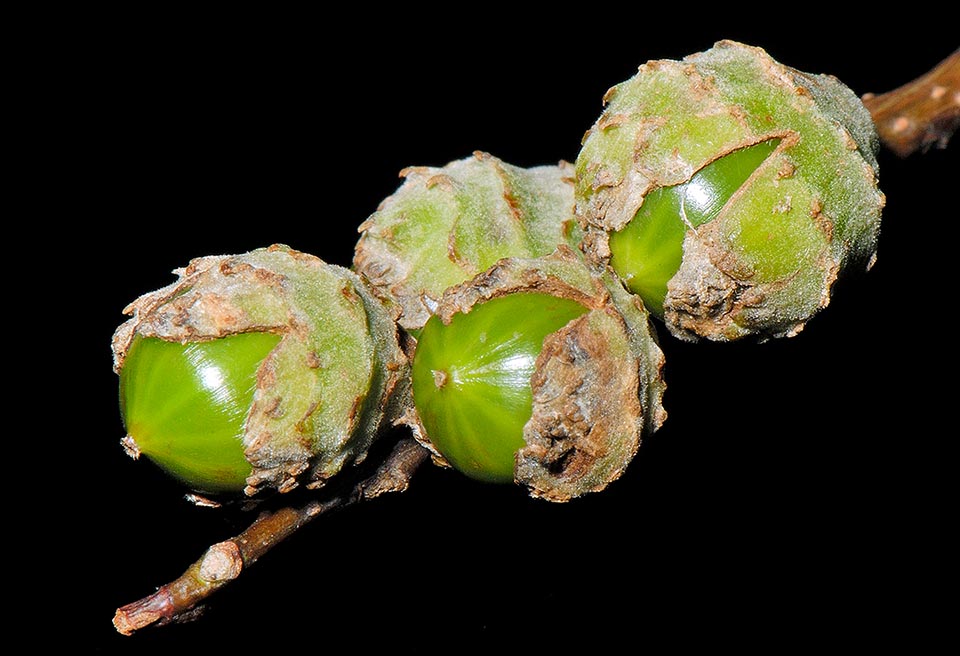
Castanopsis carlesii (Hemsl.) Hayata, Southeast Asia, also has unarmed cupules but containing only one fruit and hence has an ‘acorn-like’ look © Ming-I Weng
The genus Quercus L. is made up of numerous species (530 after Mabberley, 2017) which are more or less long-lived.
The morphological trait that immediately identifies an oak is the acorn, a solitary nut only partially included in a hemispherical cupule covered by generally approached and decurrent scales but sometimes subulate and more or less reflected or fused and arranged in rings.
The leaves are deciduous, persistent or, in some cases, semi-persistent; they are simple, dorsiventral, pinnately veined, from linear to widely ovate, pubescent, glabrous or glabrescent with more or less long petiole; the margin can be smooth, linear or lobed, or can be crenate or toothed; the deciduous oaks have leaves initially of a herbaceus consistency then become leathery whilst the leaves of the evergreen ones are rapidly sclerophyllous (leathery and thick). Leaf shapes and sizes may vary not only within the species but also on the same individual depending if it is young or adult (heteroblasty; a typical example is Quercus ilex L.).
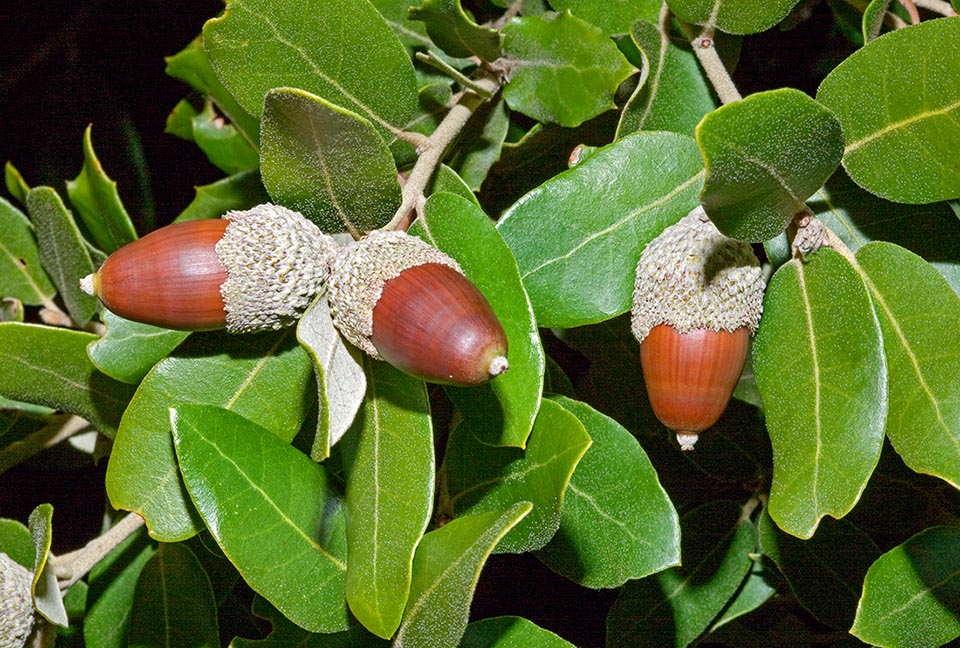
Instead the oaks fruit is a real acorn, like in the Holly oak (Quercus ilex). In Quercus some species ripe the acorn in the year, others in the second one © Giuseppe Mazza
The staminate inflorescences are slender and pendulous catkins a few centimeters long, whilst the pistillate flowers, each one surrounded by its own involucre, are solitary or carried on short and robust pauciflor spikelets.
Pollination is anemogamous, and, depending on the species, the ripening of the fruit is annual or biennial.
Denk and collaborators (2017) divided the genus in the subgenera Quercus and Cerris. The first one is distributed in 5 sections: Quercus (northern hemisphere), Protobalanus ( southern California and north-western Mexico), Ponticae (Caucasus and northern California), Virentes (south-eastern USA, Mexico, Central America and the Caribbean), Lobatae ( North and Central America, Colombia); the second in 3 sections: Cerris and Ilex (Eurasia and North Africa) and Cyclobalanopsis (tropical and subtropical Asia).
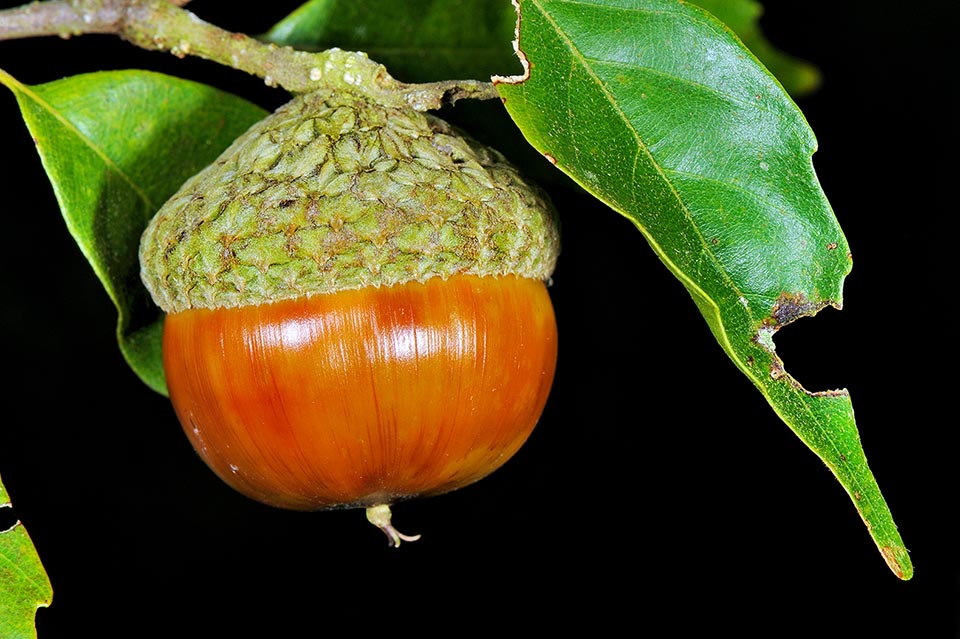
Lithocarpus konishii evokes a globose acorn, but wider than longer, partially included in a lignified and very hard discoid cupule. This is a character common to most Lithocarpus; not by chance the scientific name comes from the Greek “λίθος” (lithos), stone, and “καρπóς” (karpós), fruit © Ming-I Weng
Depending on the species, the oaks live from tropical regions up to the entire cold temperate zone very often characterizing the the local high forests.
In Europe, among the most widespread and most used native species, and, as such, also cultural heritage, Q. faginea Lam. (Portuguese oak), Q. frainetto Ten. (Hungarian or Italian oak), Q. petraea (Matt.) Liebl. (Sessile oak), Q. pubescens Willd.(Downy or Pubescent oak), Q. pyrenaica Willd. (Pyrenean oak), Q. robur L. (Common or Pedunculate oak), belong to the section Quercus, Q. cerris L. (Turkey oak) and Q. suber L. (Cork oak), to the section Cerris and Q. ilex L.(Holly or Holm oak) to the section Ilex. Among the exotic ones, the North American Q. rubra L. (Red oak; section Lobatae), is the one that has attracted the most attention for its wood as well as for its landscape value.
→ To appreciate the biodiversity within the FAGACEAE family please click here.
